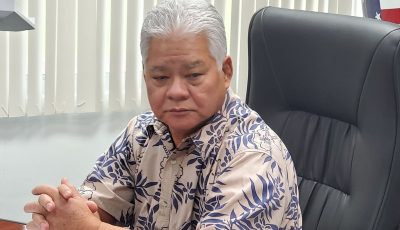Talking with tourists
I don’t yet have August’s visitor statistics for the CNMI, but, so far, it looks like China is on track to edge out South Korea as the largest source of Commonwealth visitors for the year. Globally, the Chinese are said to have claimed the position of the world’s top tourism spenders back in 2012. On this note, perhaps the only thing that exceeds the breadth of the opportunities is the height of the communications barrier.
Some readers of this column are, therefore, going to be putting their noses in Chinese textbooks. If not now, then later. I’ve been flailing around with Mandarin Chinese studies for a few years now. Today I’ll pass on a few more observations on the topic. As always, my observations are tendered with the disclaimer that I am an utterly unsuccessful student of Chinese. Commiseration, I can provide. Expertise, I cannot.
Fortunately, some experts have been posting very useful Chinese lessons on YouTube. I’ve mentioned some of these resources before. I’m on the case again because I recently found a good collection of basic lessons. These come courtesy of a teacher who posts as “Yi Zhao.” I surmise that Zhao is the surname, so I’ll call her Teacher Zhao.
Teacher Zhao’s videos come in two varieties. Most of them are a voiced lesson combined with simple text and other unostentatious graphics. I think of these as “standard” lessons. Some other lessons, by contrast, are videos of her walking around Shanghai doing various things, such as buying tea or using an ATM; I have not yet given these much attention. It’s the standard lessons that I’m going to comment on. And my comment is that many of these videos are excellent. They are focused, effective, and relevant.
And they’re also sorely needed. Although, at the basic level, I don’t think Chinese grammar is all that difficult, it does have some idiosyncrasies that merit good explanation. However, typical textbook fare and classroom lectures often give these points shoddy treatment. These points can be grasped in five minutes if they’re explained the right way, and I’ve found that it’s often someone on YouTube who knows how to do the explaining.
In Teacher Zhao’s case, some of these videos are only a few minutes long, but they explain things that probably took me hours to puzzle out back when I was just getting started.
Although I’ve used YouTube as an occasional supplement for grammar review, I’m sure that other people have inverted the equation and have figured out how to use it as a primary means of learning. Either way, I think that many of us will only figure out the best path in retrospect. But even that gets murky when you consider that the only path that really matters is the one your feet are on; all the others are mere abstractions.
Some YouTube videos have a more comprehensive scope than the short grammar videos I’ve been looking at. For example, the “HSK Academy” has posted some vocabulary reviews. These reviews rapidly move through the words on several levels of the Hanyu Shuiping Kaoshi (HSK) exams. The HSK is a test of Chinese proficiency for foreigners. There’s an entire industry devoted to HSK preparation. This ranges from books, to on-line tutor sessions, to live-in schools.
I’ve mentioned the two YouTube resources I wanted to bring to your attention today. I’ve still got the space to circle back to the grammar thing and mention a book that is proving to be an indispensable tool. It’s called Basic Patterns of Chinese Grammar, and it’s written by Qin Xue Herzberg and Larry Herzberg. It lists for $12.95. This book is clear, succinct, and practical.
Although Larry Herzberg is a professor of Chinese, he doesn’t hide behind pompous linguistic jargon. You don’t have to know any esoteric grammatical terms to use the book. That’s good for me, since I only know three grammatical terms, and I’m not even sure about two of them. Anyway, this is one book about Chinese that is written in plain English.
As I survey the pile of Chinese materials that I’ve amassed over the years, I can sure see the 80/20 rule in action. In other words, 20 percent of my materials have provided 80 percent of my progress, although that progress has been scant, I’ll admit.
When it comes to Chinese, though, a little progress is a lot better than no progress at all. I’m seeing more and more examples where this difference is a critical one in the business realm. Let’s not forget that tourism is very much a business; hey, I’m all in favor of that, since it has often rescued me from having to take boring jobs in the “real world.” I’ve been in tourism, and I’ve been out of tourism, and, baby, tourism is better.



























